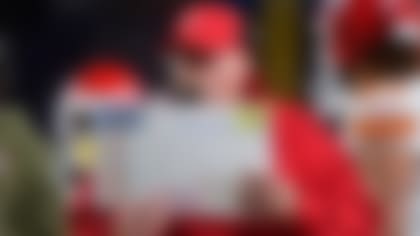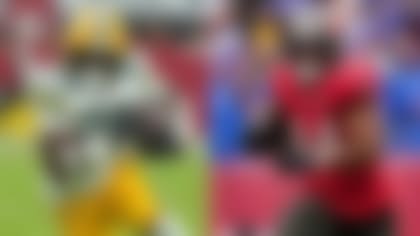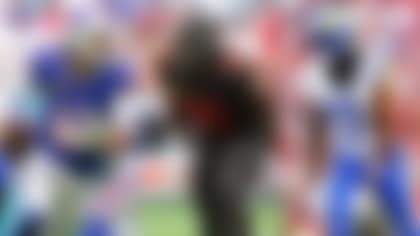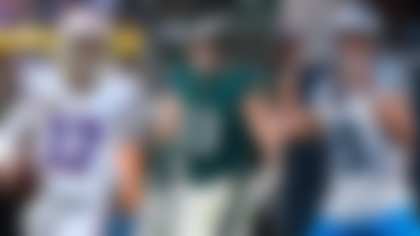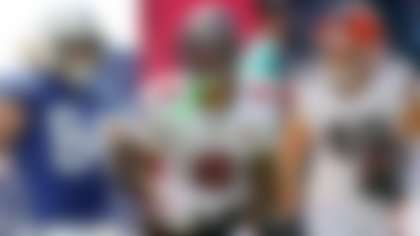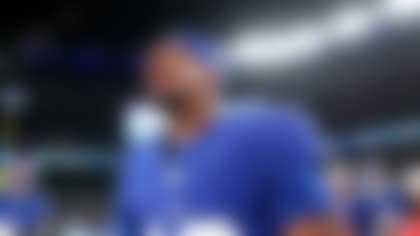Entering this season, the San Francisco 49ers were expected to contend for a Super Bowl title. In addition to a stout defense, Jim Harbaugh's team was supposed to feature a dynamic offense with a rising star at quarterback. However, the 49ers have struggled in three matchups against premier teams, scoring a grand total of 19 points over three losses to the Seattle Seahawks, Indianapolis Colts and Carolina Panthers -- leading to questions about the effectiveness of their Colin Kaepernick-led attack.
Yes, this is Kaepernick's first full season as an NFL starter, but it still is puzzling to see the 49ers' offense struggling to produce in big games. That's why I decided to take a closer look at the All-22 Coaches Film, to diagnose the factors behind San Francisco's offensive woes. Here's what I found:
1) Defensive coordinators have adjusted to Colin Kaepernick's game.
Kaepernick lit up the field as a first-time starter in the second half last season, but he certainly has not provided a worthy encore in 2013. Most of his struggles can be attributed to defensive coordinators tailoring their game plans to neutralize his strengths and take advantage of the deficiencies noticed through intense film study over the offseason. They've essentially forced the third-year pro out of his comfort zone.
One of the defensive tactics I found through my own film study is the elimination of the deep ball. Defensive coordinators have encouraged their cornerbacks to take away vertical routes by playing aggressive press coverage at the line of scrimmage with slightly outside leverage. Additionally, cornerbacks are staying on top of Niners receivers with "top down" leverage -- i.e., cornerbacks are forcing receivers to catch the ball coming back to the quarterback as opposed to staying in the receiver's hip pocket and encouraging Kaepernick to push the ball down the field.
In the screengrab below, taken from the 49ers' Week 2 loss to the Seahawks, Richard Sherman is matched up with Vernon Davis on the outside. Sherman is playing press coverage with a slightly outside technique to take away the quick fade route to the boundary:
After the snap, Sherman forces Davis to the sideline while maintaining proper positioning on the receiver to make a play on the ball:
Sherman's picture-perfect technique and excellent ball skills lead to an interception.
Defensive coordinators are taking away throws outside the numbers, too, forcing Kaepernick to direct the majority of his passes over the middle. By funneling receivers between the hashes in man or zone coverage, the defense forces Kaepernick to make contested throws between multiple defenders. These throws, which require superb anticipation, awareness and accuracy, would be challenging for any young quarterback, but they're particularly so for one who is most comfortable throwing off play action.
The next series of screengrabs shows how defenses are forcing Kaepernick to make contested throws over the middle. The Seahawks are aligned in press coverage below, with defenders instructed to play tight man technique:
With the timing and direction of the routes altered, Kaepernick is forced to throw into the teeth of the defense. The ball is thrown slightly off target, resulting in another interception:
Last season, the 49ers shredded opponents with a variety of vertical throws following strong read-option play fakes. Facing a potent ground attack, opposing linebackers were forced to aggressively react to play action, leaving huge windows for receivers downfield. In the 2013 campaign, Kaepernick is being forced to play the game in a traditional manner (something he is uncomfortable doing at this point in his career). Why? Well, that leads into our next point ...
2) A lack of explosiveness at receiver has grounded the passing attack.
What was one of the NFL's most explosive offenses last season has struggled mightily in big games this season. The Niners have averaged a healthy 34.7 points per game in their six wins, but that figure drops to 6.3 in their three losses. Given the fact that most NFL offenses generate the majority of their production from the passing game, it is obvious something is going seriously awry with the 49ers' aerial attack in heavyweight battles -- and it's not just about Kaepernick's growing pains.
Looking at the film, the first thing that stands out is the lack of speed and explosiveness on the perimeter. The 49ers' receiving corps lacks a legitimate vertical threat outside of Davis (a tight end), which makes it tough to generate big plays. Of course, the absences of Mario Manningham (the sixth-year pro missed the team's first eight games before returning to the lineup in Week 10) and Michael Crabtree (who's still out) due to injuries greatly contributed to this lack of juice.
Coming into the season, many observers expected the passing attack to continue to thrive behind Anquan Boldin and Davis. And there was plenty of buzz circulating around the NFL after Boldin's impressive 49ers debut (13 catches for 208 yards and a touchdown in a Week 1 win over the Green Bay Packers). Boldin was viewed as a legitimate between-the-hashes threat, which theoretically would help Kaepernick improve his production on passes over the middle.
Defensive coordinators, however, quickly adjusted to the 49ers' utilization of Boldin by incorporating more press coverage into their respective game plans. The Seahawks and Colts, in particular, crowded the veteran at the line of scrimmage and used a variety of mug tactics to neutralize his effectiveness on the perimeter. Constant harassment on the perimeter has disrupted the timing of the passing game, forcing Kaepernick to hold on to the ball longer within the pocket. Consequently, the QB is on pace to take more sacks this season; he routinely looks uncomfortable in the pocket, as evidenced by the video clip just above.
With opponents intent on taking away Boldin, the onus has fallen to an inexperienced and ill-prepared group of receivers to pick up the slack. Unfortunately, the 49ers' supporting cast (which has included Quinton Patton, Jon Baldwin and the recently released Kyle Williams) hasn't been able to win consistently in big games. Factor in that Davis has missed significant playing time in each of the 49ers' three losses due to hamstring/concussion issues, and the passing struggles are anything but surprising.
In the following screengrab, taken from the 49ers' Week 3 loss to Indianapolis, Colts defensive backs are positioned in press coverage against the 49ers' ace formation:
Without a receiver to target, Kaepernick eventually is forced to run out of bounds for a 1-yard loss.
That's why the impending return of Crabtree is critical to the 49ers' Super Bowl hopes. The fifth-year pro was starting to play like an elite receiver on the perimeter last season, with 85 receptions for 1,105 yards and nine touchdowns. Most importantly, Crabtree emerged as Kaepernick's go-to guy. Although he certainly will need some time to shake off the rust when he returns, Crabtree's re-insertion into the lineup will allow the rest of the unit to return to their customary roles: Davis can become the matchup nightmare, while Boldin can act as the third-down/red-zone weapon and Manningham can be the deep-ball specialist.
3) Opponents are taking away the quarterback run on read-option plays.
Harrison: Week 11 Power Rankings
After another wild week, there's plenty of movement in Elliot Harrison's NFL pecking order. Where is your team ranked? **READ**
The 49ers' clever utilization of the read option during a remarkable postseason run forced opposing coaching staffs to trek across the country looking for ways to defend the concept. Defensive coaches and players boldly promised to pummel quarterbacks on these plays all offseason in an attempt to discourage the tactic. Although the bark has been a bit louder than the bite, opponents certainly have made a concerted effort to knock down the quarterback at every opportunity.
Looking at each of the 49ers' losses, I've seen a stronger commitment to eliminating the QB run option on zone-read plays. While the focus on hitting Kaepernick has left opponents vulnerable to the inside running game, taking away one of the 49ers' most explosive weapons has been the primary objective of defensive play callers.
In the next series of screengrabs, Indy's defense illustrates how to correctly defend the 49ers' read option. Outside linebacker Bjoern Werner will crash to take the dive, while inside linebacker Jerrell Freeman will scrape to take the quarterback in the alley:
On the snap, Werner crashes hard to force Kaepernick to keep the ball and bounce to the outside:
Meanwhile, Freeman scrapes fast to take away the outside:
Without an open lane on the perimeter, Kaepernick is stuffed by Freeman for a 5-yard loss.
The Carolina Panthers did a fine job attacking the read option in their 10-9 win over San Francisco this past Sunday. In the screengrab below, the Panthers have eight men in the box. Defensive end Greg Hardy is assigned to the dive, with safety Mike Mitchell scraping to the quarterback:
On the snap, Hardy crashes hard to the dive, but shows the awareness to stay in front of Kaepernick. Meanwhile, Mitchell runs the alley quickly to cover the quarterback if he successfully escapes:
No escape this time, as Hardy snatches Kaepernick for a 6-yard loss:
How can the 49ers combat some of the tactics opponents are using to defend the read option? San Francisco could incorporate more bubble screens to slow down defenders on the perimeter or tweak blocking schemes to use more slip blocks (when the fullback works around the defensive end to seal the outside linebacker on the play side) and provide Kaepernick with an escort down the field.
One thing is clear: Harbaugh and offensive coordinator Greg Roman must get their most explosive weapon back on track.
Follow Bucky Brooks on Twitter @BuckyBrooks.

